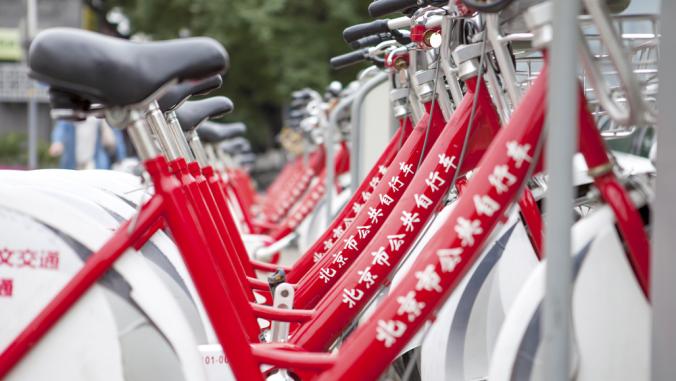(Solar) Power to the People
<p>The co-founder of Sungevity talks about the drive for climate legislation, the booming market for solar power systems, and whether it can bring renewables to the masses, one roof at a time.</p>

Some things have changed since Danny Kennedy left Greenpeace to become president of Sungevity, a startup company that sells rooftop solar power to homeowners.
Others have not.
Kennedy now talks easily about ROI and IRR -- that’s return on investment and internal rate of return, for the corporate-impaired -- and he says buying solar panels for the roof of your home, if you live in a state with favorable subsidies, is a “very good, long-term, high-performing investment.” In other words, he’s learned to be a salesman.
But he’s still an activist at heart. We had lunch this week in Washington, where Kennedy joined more than 100 business leaders who are part of a clean-energy coalition to push the U.S. Senate to pass climate legislation. “What drives me now,” he says, “is the same thing that drove me at Greenpeace -- the desire to solve the climate change problem with low-carbon energy and create jobs and wealth along the way.”
 Danny, who is 38, launched Sungevity on Earth Day, 2008, at FORTUNE’s Brainstorm Green conference. His co-founders are the company’s CEO, Andrew Birch, who had worked at BP Solar and board chairman Alec Guettel, an entrepreneur who’d started two companies after working at EPA during the Clinton administration. Danny and Alex met 20 years ago as youth delegates to an environment conference. Later, Danny, who grew up in Australia, worked on environmental and human rights issues for Greenpeace, becoming campaigns manager for Greenpeace Australia Pacific.
Danny, who is 38, launched Sungevity on Earth Day, 2008, at FORTUNE’s Brainstorm Green conference. His co-founders are the company’s CEO, Andrew Birch, who had worked at BP Solar and board chairman Alec Guettel, an entrepreneur who’d started two companies after working at EPA during the Clinton administration. Danny and Alex met 20 years ago as youth delegates to an environment conference. Later, Danny, who grew up in Australia, worked on environmental and human rights issues for Greenpeace, becoming campaigns manager for Greenpeace Australia Pacific.
Thanks largely to subsidies, California’s residential market for solar panels is growing and crowded. That’s a good thing, because the competition will drive down costs, improve quality and help make the business case for rooftop solar. (I wrote recently about SunRun, a competitor to Sungevity.) Sungevity’s competitive edge is software that enables the company to provide a cost estimate to a homeowner without dispatching a crew to measure the roof. This makes it easy for customers to order solar panels and, of course, it reduces costs.
“Sungevity took a leaf out of Dell’s book,” Danny says. “We want to go direct to the customer.” The company works with a variety of suppliers, and outsources installation. “We’re completely technology-agnostic,” he says. Essentially, Sungevity is a software and marketing company. It has about 30 employees.
The Sungevity approach isn’t for everyone. Some customers want hand-holding before ordering a solar photo voltaics, which can be a substantial investment -- easily $20,000 or more. So far, the company has orders from about 250 homes.
Sungevity raised about $2.7 million from friends and family back in 2007 and recently raised another $6 million from the original investors and a small venture capital firm called Greener Capital.
Because of the global economic slump, there’s a surplus of manufacturing capacity for solar panels and costs are dropping. “This is the best time in history to buy solar,” Danny says. In California, homeowners can take advantage of utility company rebates covering 15 to 20% of the costs, as well as the 30% federal tax credit for solar. In places where electricity costs are high, “the economics are unbelievable,” he says.
{related_content}If you are a believer in solar PV -- and I’m not persuaded yet that the costs will come down to a place where the industry can thrive without subsidies -- an interesting question arises: Should it be distributed on rooftops, or centralized in utility-scale power plants to take advantage of economies of scale?
By coincidence, the day after seeing Danny, I visited with executives of Edison International, which operates Southern California Edison, the big regulated utility in southern California. They told me that it’s much cheaper and more efficient to aggregate lots of solar PV or deploy solar thermal technology in the desert. (Solar thermal uses the sun’s heat, not its light, to generate electricity. See my recent blogpost about Bill Gross and eSolar) The Edison execs also told me that they are being required by regulation to pay artificially high rates to homeowners with rooftop solar who sell the electricity they don’t use back into the grid. If so, that’s effectively a subsidy from the poor and working class to the wealthy who can afford solar.
The issue isn’t simple. For one thing, we all benefit from carbon-free electricity. For another, Danny points out that rooftop solar does not require new transmission lines and avoids the potential problem of “energy sprawl,” which is the idea that lots of land will be needed for solar and wind plants as they scale up.
Those like Danny who think we should generate electrical power closer to the people like to compare the energy grid to the Internet, where distributed computing power (in desktops and laptops) has largely triumphed over centralized power in big mainframes.“Distributed energy will prevail, more quickly than people expect,” Danny says.
I’m not so sure -- the scale of the energy and climate problem is so big that it’s hard for me to believe that we can solve it one rooftop at a time.





